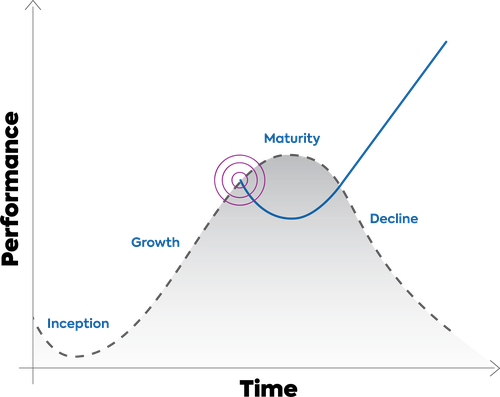
In our Goldilocks-style search for the ‘just right’ technology for each client’s project, it’s vital that we’re not caught napping.
Because choosing the most appropriate components for the tech stack – the collection of technologies we use to build an application – is about much more than the technology itself.
In fact, It’s about thinking beyond the big boys, resisting the shiny and hitting the sweet spot according to exactly where the individual client currently sits on the innovation curve.
Get it wrong and we could leave them straining under the financial burden of expensive licences and support contracts; or conversely, high and dry with a broken app and no business, because a crucial bit of software has been phased out.
So, if you’re considering your own tech stack for an upcoming project, these are the business-crucial questions we ask to make sure there’s a happy ever after.
Curves and right places

.
When we say tech selection is a business decision, let’s imagine a few scenarios.
At the very beginning of the curve, startup entrepreneurs might choose technologies that are tightly coupled to their specific needs. They know they’ll hire and develop a team that works only with their stack, so they can merrily invent their own tooling and techniques, knowing their own people have it expertly in hand.
Jump much further along the curve, to the mature phase, and you’ll find big enterprises. These cash-rich behemoths want systems that are developed and supported by other enterprises. Because the important element to them is reliability over the long term.
They’ll pay top whack salaries for people who know these systems, to give the board peace of mind that everything will work. And often, they’re happy to sign up to a large range of systems because they have the scale and deep pockets to use specialists in all of them.
Stacks for the rest of us
But what about everyone in between? Most of our clients don’t want to shell out for the expensive licences and support contracts that mammoth vendors charge. But they do want something that isn’t a huge surprise to future hires – or potential acquirers. They want tech that behaves and performs predictably, and they want to keep things tight, so they don’t need an army of different experts to keep their business marching along.
Fad or future?
Seduction by the shiny and new is something we face a lot. And it takes a cool head to resist.
If you stand far enough back, most languages, databases and solutions do broadly the same things as their direct rivals. But when a hot newcomer creates an impressive buzz, clients will often ask if we can use something they’ve heard being hailed as sliced bread 2.0.
If it’s not your world, picking out what’s got staying power and what’s a mere will-o’-the-wisp isn’t always easy. And that’s where expertise really earns its fee. Our job is to curate the choices and make sure that no matter how many cooler, cheaper, faster or more scalable candidates might come along, we build our customers a system that hits six criteria, as identified by our architecture team.
Those criteria we have outlined are that the system:
- will continue to be supported for the next five to ten years
- has a good track record for security
- doesn’t need constant maintenance
- people know how to work with effectively
- has established well-understood patterns for use, making it easier to support in the long term
- is well supported by cloud providers, who understand it and will continue to support it.
A finger on the pulse
If you’re eyeing a solution with interest but you’re not sure if it’s about to vanish like a your teenage kids when it’s time to wash up, technology radars can help. We like this one from Thoughtworks, or check out the thoughtful findings in Github’s poptastic language top 10.
(Incidentally, if you don’t think your seductive shiny is heading the way of fidget spinners, Babylon Zoo and jelly shoes, administer yourself a dose of reality with this Tumblr thread. It catalogues a long list of promising ventures that were bought out by hyperscalers hungry to snap up the team behind them, before being slipped, inexorably, into the ether. Its title, Our Incredible Journey, pays homage to the inevitable wording in the post-acquisition death knell statement, which thanks users for being part of the initiative’s brief existence.)
But what would you do?
We’ve always got a weather eye out for solid tech advances that pass our test summarised above – but if it helps to peep behind the Isotoma curtain, we asked founder and CTO Doug Winter for the headline elements of our current standard technology stack, which he lists as:
- Typescript or Python as a programming language
- Amazon Web Services
- Postgres for relational databases and DynamoDB for NoSQL
- Redis for caching
- CDK for Infrastructure as Code
So, if you’re embarking on a similar project, make sure you’re choosing the right tech for your business; not for the corporate you used to work in, your mate’s startup, or even your business five years ago. And if you need help with that, get in touch.

